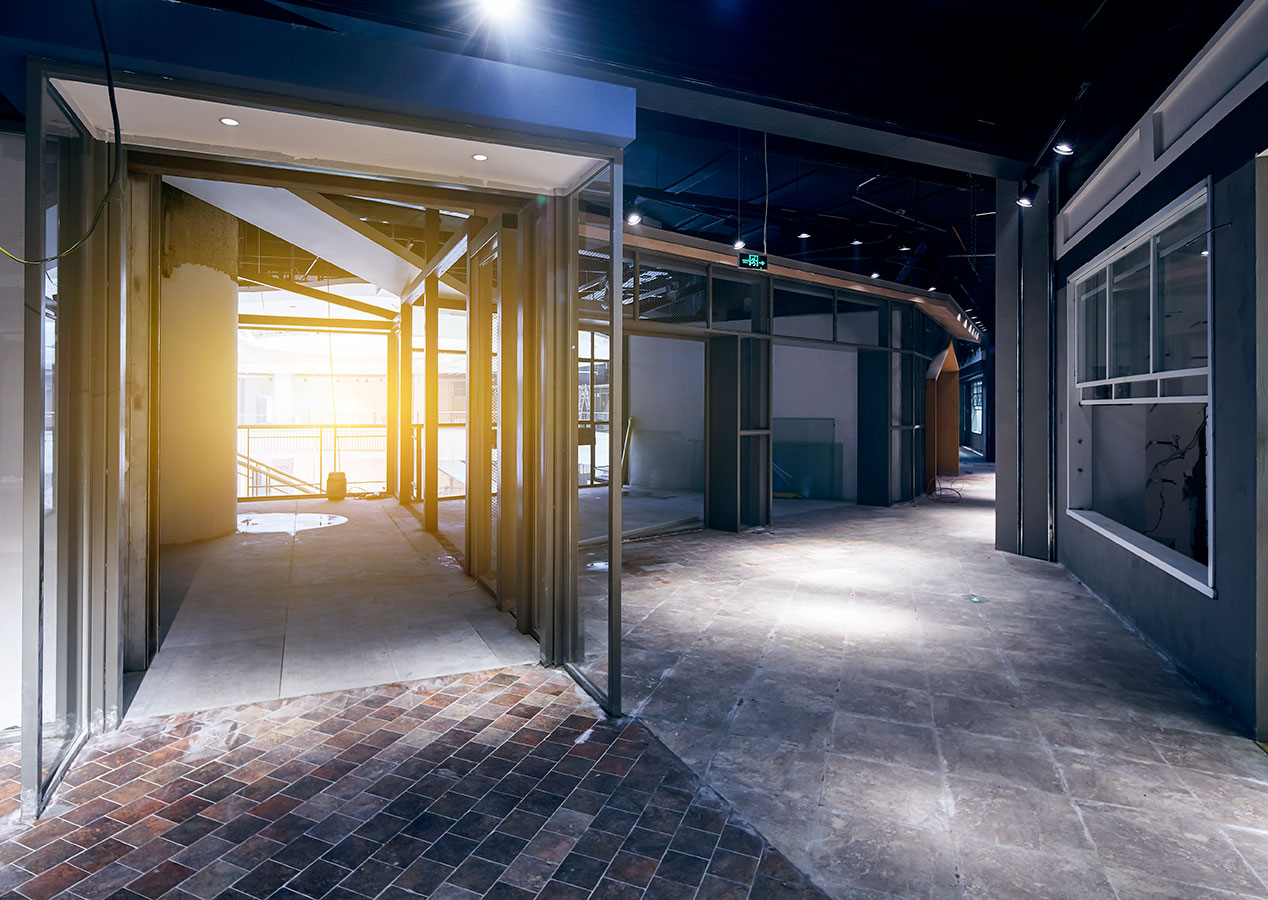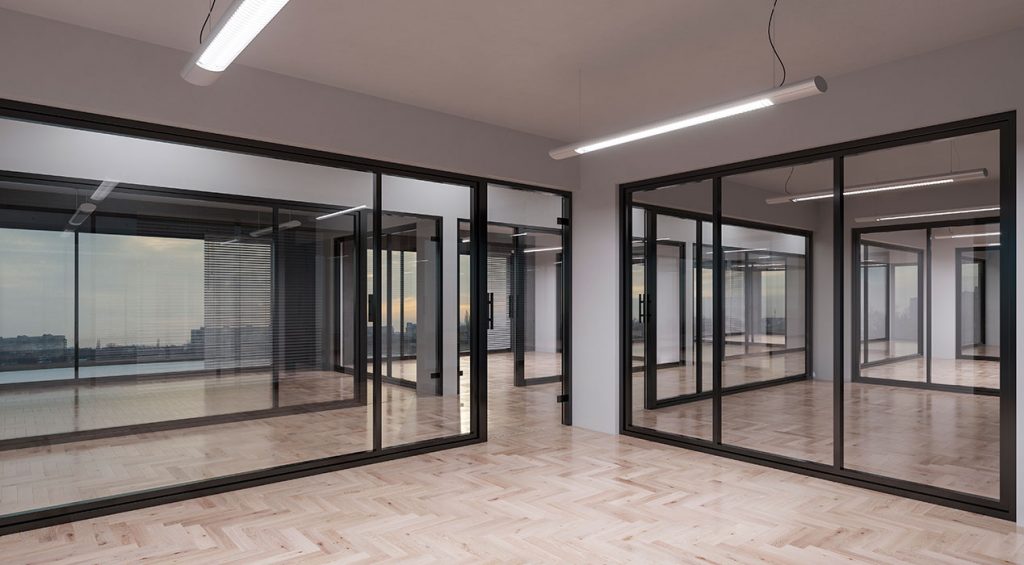To build or to remodel: what’s better for your commercial property?

Whether you’re starting a new business or expanding an established company, one of the first questions you’ll tackle is whether you should remodel an existing commercial property or build one from the ground up. Both options have pros and cons. The correct choice for you involves many factors.
In this article we present some of the most important considerations to take into account when making this important decision. First, let’s make something clear.
Remodel vs. Renovation
While often used interchangeably, these terms refer to two different things.
renovate = restore to good condition, make new or as-new again, repair
remodel = reconstruct, to make over, to model again
A renovation is the process of restoring a space or building to a previous state. It updates a room or building without changing its intended purpose and may include a new paint job, flooring, lighting fixtures, etc. For example, an office remains an office after a renovation; a kitchen remains a kitchen.
Remodeling involves the altering of a space or building into a new state. It is a remake that typically involves more drastic changes through which, for example, an office becomes a kitchen and break room for employees.
To Build or to Remodel: 7 Factors to Consider
Here are a few things to think about when deciding whether to build or remodel a commercial property.
1. Cost
Most people assume that building a new structure is more expensive than remodeling an existing one. But that’s not always the case. The cost of either type of project depends on the scope of the work involved as well as other factors that affect the budget. While new construction tends to be more costly, older buildings often face code compliance issues that can be expensive to address.
Build
The price tag of building a new commercial property can vary widely, but it’s generally more expensive than remodeling a building. In addition to construction costs, building a new facility from the ground up usually involves appraisal costs, a down payment, loan origination and closing fees, architectural design fees and building inspection fees, among other costs. New construction often requires the purchase of land and, in some cases, the cost to establish new connections to utilities and to comply with zoning requirements, such as adding fire hydrants and drainage areas.
There are also soft costs involved. Ground-up construction usually takes longer to complete than a remodel, and delays could adversely affect your company.
Remodel
Remodeling a relatively modern building ordinarily is more cost-effective for companies that need to improve or expand their business space. Thanks to inflation and pandemic-related supply chain disruptions and labor shortages, prices for numerous construction materials–such as steel and lumber–as well as for fuel, transportation, equipment and tools, and the wages paid to construction workers are skyrocketing. These price hikes are making remodeling an existing property more attractive than building a new one for many businesses, especially small ones.
To determine whether new construction or remodeling would cost you more, get quotes for both projects.
2. Timeline
New construction and remodels happen on different timelines. Consider both of these timelines when trying to decide which one is right for your business.
Build
Building a commercial property from the ground up takes a long time, typically months to a year or more. Construction is a complex process that involves a number of phases that span from planning to delivery. On the other hand, new construction has minimal impact on day-to-day business operations because these continue as always in their current space while the new space is being built.
Remodel
Remodeling an existing property takes less time, usually weeks to months. Even large remodeling projects are likely to take less time than new construction because they tend to be significantly less complicated than ground-up construction projects. This shorter timeline is better suited for businesses that are on a tight deadline or can’t afford the downtime or relocation involved in new construction. Remodeling also can take place in the same space where people are working, albeit not without some level of disruption. To minimize workplace disruptions, contractors can do most of their work at night and on weekends.
3. Investment Return
Return on investment (ROI) is another factor that property and business owners must take into consideration when deciding between building or remodeling a commercial property.
Build
Depending on the real estate market in your area, a newly built facility has the potential to appreciate in value, so you could potentially make a profit on your investment in the future if you decide to sell it. Another way to see ROI on new construction is to build a larger facility and lease the additional space to generate rental income. This allows you to offset your investment costs while retaining the option of expanding in that site as your company grows. Adding retail or office spaces can benefit your businesses by increasing foot traffic around it.
New construction may offer access to tax breaks, grants and loans. For example, building your property in a high unemployment area may give you access to tax breaks for creating new jobs. Sometimes these benefits are also available for remodeling projects.
Remodel
It is possible to obtain ROI with a remodeling project, but it depends on the changes made to the building and how these affect productivity and sales, if at all.

4. Financing Advantages
The decision to build or remodel may come down to the financing options available for your project.
Build
Usually, it’s easier to secure a loan for new construction. More lenders provide loans for ground-up construction, especially for owner-occupied buildings, than for remodeling existing properties. Most of these loans include a construction contingency that adds about 10% to the project’s cost estimate, making the deal safer for lenders and borrowers. Some lenders also offer an interest reserve, which allows interest-only payments from the borrower to be added into the total cost of the project, so the borrower doesn’t have to make any payments on the project until it is completed and can be occupied.
5. Business Needs and Customization
Another critical factor to consider when deciding whether to build or remodel is how much freedom you need to create a space that can meet your business needs. For obvious reasons, building from the ground up offers more customization options than remodeling an existing space.
Build
New construction allows you to create a space that serves the specific needs of your business versus having to work around the specifications and limitations of an existing space. Building your own facility affords you the opportunity to design a space that is the right size and style and has the right layout and features you need to operate more efficiently.
Ground-up construction enables you to choose a location that has the right traffic, tax rates and demographics for your business. It also allows companies to take advantage of state-of-the art technology and energy efficient systems that bring about long-term savings.
Remodel
When new construction is not an option, you can remodel your existing space to conform it to your company’s business needs.
6. Sustainability
In this day and age, sustainability is an important factor that companies can’t ignore when building or remodeling a commercial facility.
Remodel
In most cases, remodeling, and therefore reusing, a building is deemed more sustainable than ground-up construction. Building a new property commonly produces more carbon emissions and more debris and solid waste than remodeling an existing one. Commercial property owners who want to make their businesses as sustainable and energy-efficient as possible often choose to remodel rather than to build from the ground up.
7. Restrictions
Commercial buildings are restricted by local building codes and regulations, including zoning laws. Property and business owners must take both of these factors into account when building new structures or remodeling existing ones. For example, if your business is in a building that has structural challenges, permitting restrictions (such as historical status), you may not be able to modify it to meet your needs. In this case, you’re better off building from scratch or buying a building you can remodel.
Are you ready to build or remodel your commercial property? At CIC Construction Group we help businesses and commercial property owners sort through their choices and make informed decisions that will contribute rather than hinder their success. We provide numerous construction services, including pre-design, design-build and general contractor services, for a wide variety of commercial, industrial and residential projects. Contact us today to discuss your project and how we can be of assistance to you.
